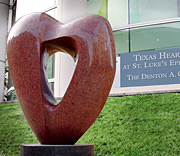Researchers transplant regenerated esophagus
Texas Heart Institute’s Dr. Doris Taylor On International Team Achieving Milestone
(Houston - April 16, 2014) Tissue engineering has been used to construct natural esophagi, which in combination with bone marrow stem cells have been safely and effectively transplanted in rats, according to a study published today in the prestigious online journal, Nature Communications. The study, shows that the transplanted organs remain patent and display regeneration of nerves, muscles, epithelial cells and blood vessels.
The new method has been developed by researchers at Karolinska Institutet in Sweden, within an international collaboration lead by Professor Paolo Macchiarini, and including
Dr. Doris Taylor, Director of
Regenerative Medicine Research at the Texas Heart Institute (THI).
The technique to grow human tissues and organs, so called tissue engineering, has been employed so far to produce urinary bladder, trachea and blood vessels, which have also been used clinically. However, despite several attempts, it has been proven difficult to grow tissue to replace a damaged esophagus.
In this new study, the researchers created the bioengineered organs by soaking esophagi from rats to remove all the cells. With the cells gone, a “scaffold” remains in which the structure as well as mechanical and chemical properties of the organ are preserved. The produced scaffolds were then reseeded with cells from the bone marrow of the recipient. The adhering cells have low immunogenicity which minimizes the risk of immune reaction and graft rejection and also eliminates the need for immunosuppressive drugs. The cells adhered to the biological scaffold and started to show organ-specific characteristics within three weeks.
The cultured tissues were used to replace segments of the esophagus in rats. All rats survived and after two weeks the researchers found indications of the major components in the regenerated graft: epithelium, muscle cells, blood vessels and nerves.
“We believe that these very promising findings represent major advances towards the clinical translation of tissue engineered esophagi”, says Paolo Macchiarini, Director of Advanced center for translational regenerative medicine (ACTREM) at Karolinska Institutet.
“We are very excited and honored to be a part of the team taking such heroic steps that will ultimately benefit so many patients throughout the world,” said Dr. Taylor who is leading ground-breaking organ-building work at the Texas Heart Institute that may ultimately lead to the ability to grow new hearts and other organs using a patient’s own stem cells.
Dr. Taylor has collaborated with Professor Macchiarini for several years and they have jointly published previous papers on tissue engineering. She and THI are in the midst of multiple international collaborations in this field.
“The joint goal is to discover, develop, and take first steps toward delivering a more complex tissue, such as a heart,” added Dr. Taylor. “We see this as another important milestone along that path, which we expect will ultimately help many millions of patients.”
Dr. James T. Willerson, President of the Texas Heart Institute, added that, “this is a very important step forward toward the goal of regenerating tissues using Dr. Taylor’s methods. The ability to regenerate a patient’s esophagus after it has been injured would help many people. The same is true for an injured heart.”
With regard to the esophagus study, tissue engineered organs could improve survival and quality of life for the hundreds of thousands of patients yearly diagnosed with esophageal disorders such as cancer, congenital anomalies or trauma. Today the patients’ own intestine or stomach is used for esophageal replacements, but satisfactory function is rarely achieved. Cultured tissue might eliminate this current need and likely improve surgery-related mortality, morbidity and functional outcome.
The current study was conducted in collaboration with universities in Italy, Russia, Germany and the U.S. It was supported financially by, among others, the Swedish Research Council, the Stockholm County Council through the ALF agreement, and the European Union’s Seventh Framework Programme. The equipment used in the study was developed by the company Harvard Apparatus Regenerative Technology.
The paper published in Nature Communications is entitled “‘Experimental orthotopic transplantation of a tissue-engineered oesophagus in rats.” Its authors include Sebastian Sjöqvist, Philipp Jungebluth, Mei Ling Lim, Johannes C. Haag, Ylva Gustafsson, Greg Lemon, Silvia Baiguera, Miguel Angel Burguillos, Costantino Del Gaudio, Alexander Sotnichenko, Karolina Kublickiene, Henrik Ullman, Heike Kielstein, Peter Damberg, Alessandra Bianco, Rainer Heuchel, Ying Zhao, Domenico Ribatti, Cristián Ibarra, Bertrand Joseph, Doris A. Taylor and Paolo Macchiarini.
___________________________________________________________
Karolinska Institutet is one of the world’s leading medical universities. It accounts for over 40 percent of the medical academic research conducted in Sweden and offers the country’s broadest range of education in medicine and health sciences. Since 1901 the Nobel Assembly at Karolinska Institutet has selected the Nobel laureates in Physiology or Medicine. For further information, contact Karolinska Institutet. Telephone: +46 760503213.
About the Texas Heart® Institute: The Texas Heart Institute (www.texasheart.org), founded by world-renowned cardiovascular surgeon Dr. Denton A. Cooley in 1962, is a nonprofit organization dedicated to reducing the devastating toll of cardiovascular disease through innovative and progressive programs in research, education and improved patient care. Together with its clinical partner, Baylor St. Luke’s Medical Center, it has been ranked among the top 10 cardiovascular centers in the United States by U.S. News & World Report’s annual guide to “America’s Best Hospitals” for the past 23 years. The Texas Heart Institute is also affiliated with the University of Texas (UT) System, which promotes collaboration in cardiovascular research and education among UT and THI faculty at the Texas Heart Institute and other UT components.
For media inquiries please contact:
Director of Public Affairs
Texas Heart Institute
Frank Michel ♦ 832-355-9510 ♦ fmichel@texasheart.org
For THI media profile, see Public Affairs.



